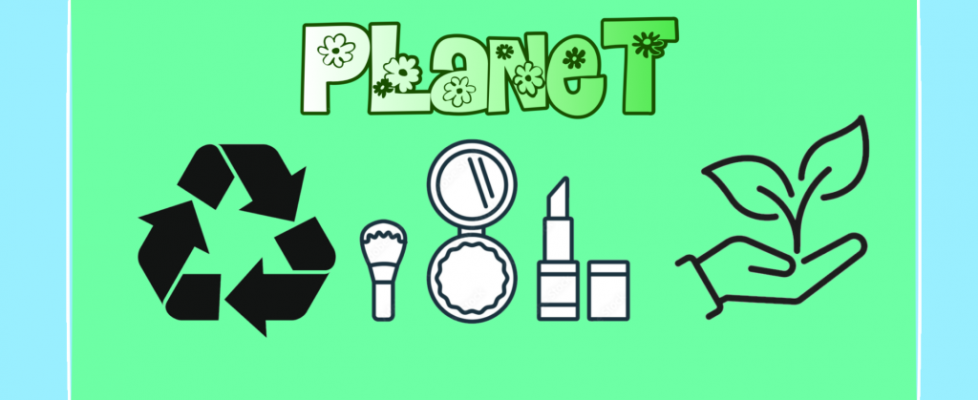Planet
Planet is one of the four pillars in the cosmetics industry. This pillar is related to sustainability and the focus on the different practices used in this industry in order to reduce its impact on the environment through different ethical practices. The beauty industry is one of the biggest contributors to global warming; with it wasting around 120 billion units of packaging per year.
The circular economy (CE) refers to an economic system that is based on the reuse and regeneration of materials or products, especially as a means of continuing production in a suitable or environmentally friendly way. This system is important in the cosmetics industry as different brands are aiming to improve their environmental sustainability through new integrated strategies, using the concepts of CE. Research shows that to the majority of the population, the CE is defined as a combination of reduce, reuse and recycle activities. (Morea et al., 2021) A circular economy is based on four principles, which are: limiting waste, reuse where possible, recycle, and recover to turn waste into resources. This economic system can be very beneficial to the environment as it helps different cosmetic brands to reduce the demand for virgin raw materials and leave room for models of reuse and recycling of products, therefore helping to minimise the environmental impact that is caused (Morea et al., 2021).

In relation to cosmetics, sustainability refers to beauty companies ensuring that they follow ethical practices in order to reduce their negative impact on the environment. Furthermore, it is important for cosmetic brands to ensure that their products are manufactured using natural and eco-friendly ingredients that are produced from renewable raw materials (Hitce et al., 2018). The majority of companies that have prioritised sustainability have claimed to surpass their competitors due to their improved reputation and consumer satisfaction which has resulted from the use of resources efficiently, and by reducing the amount of wasted products and ingredients (Rocca et al., 2022).
Life Below Water is a SDG that has relevance and an impact on the cosmetics industry. This goal focuses on conserving and sustainably using the oceans, seas, and marine sources. Marine pollution is currently at very high levels, with over 17 million metric tons clogging the ocean in 2021, and with a pH average of 8.1 (United Nations, 2023). The cosmetics industry is one of the biggest contributors to marine pollution; this is due to the fact that plastic is often used in the packaging of different cosmetic products. When disposed, this plastic will end up in the ocean, which will not only affect the marine life, but also humans. This is because toxic microplastics can get into the bloodstream of any organisms, which can block the transportation of oxygen around the body (Barton et al., 2021).
Reference list
Barton, S., Eastham, A., Isom, A., McLaverty, D., and Soong, Y.L. (2021) London: Royal Society of Chemistry. Introduction to cosmetic science. 10.5 Do Cosmetics Pollute the Oceans? Available from: https://www-vlebooks-com.arts.idm.oclc.org/Product/Index/2086261?page=0&startBookmarkId=-1 [Accessed 7th October 2023]
Hitce, J., Xu, J., Brossat, M., Frantz, M. C., Dublanchet, A. C., Philippe, M., & Dalko-Csiba, M. (2018). UN sustainable development goals: How can sustainable/green chemistry contribute? Green chemistry as a source of sustainable innovations in the cosmetic industry. Current Opinion in Green and Sustainable Chemistry, 13, 164-169. [Accessed 1st October 2023]
Morea, D., Fortunati, S., & Martiniello, L. (2021). Circular economy and corporate social responsibility: Towards an integrated strategic approach in the multinational cosmetics industry. Journal of Cleaner Production, 315, 128232. [Accessed 29th September 2023]
Rocca, R., Acerbi, F., Fumagalli, L. and Taisch, M., (2022) Sustainability paradigm in the cosmetics industry: State of the art. Cleaner Waste Systems, p.100057. [Accessed 6th October 2023]
United Nations (2023) The Sustainable Development Goals Report 2023: Special Edition. Available from: https://unstats.un.org/sdgs/report/2023/?_gl=1*1mg145*_ga*ODg1NTQxOTUwLjE2ODcwMTUzNDA.*_ga_TK9BQL5X7Z*MTY5NjcwNTMzMC41LjAuMTY5NjcwNTMzNS4wLjAuMA.. [Accessed 7th October 2023]
Images reference list
Figure 1a: Cosmetics Europe (2017) Environmental sustainability in action. Available from: https://cosmeticseurope.eu/news-events/environmental-sustainability-action [Accessed 4th October 2023]
